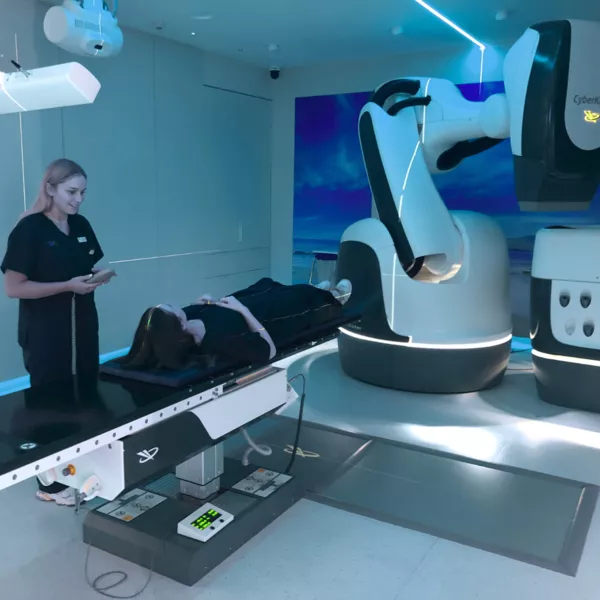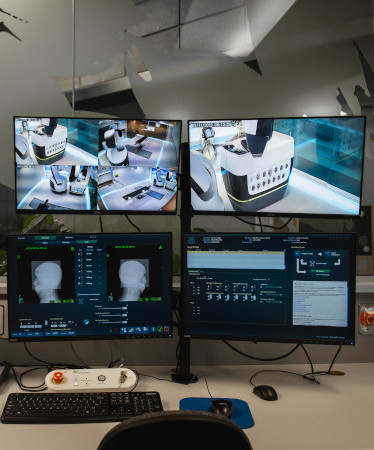AROs Chief Physicist Explains CyberKnife
Thu July 17th 2025
If you’ve never heard of CyberKnife, the name alone might conjure up images of science fiction. And when you see it in action, a sleek robotic arm moving with precision and agility, it certainly looks futuristic. One of our patients described it perfectly:
“The robotic arm moves with incredible agility and accuracy over me, side to side, even underneath the table… I lay completely mesmerised by the machine’s grace and power.”
But this isn’t science fiction, it’s very real, and it’s changing the way cancer is treated around the world. To help demystify how it works, we spoke with Dr Ian Hanson, Chief Physicist at Auckland Radiation Oncology (ARO), to learn more about CyberKnife and what makes it so unique.
What is CyberKnife
Dr Hanson explains that CyberKnife belongs to a group of radiation therapies called SBRT or stereotactic radiation therapy. This technology uses advanced imaging and computer-guided planning to pinpoint the exact location of a tumour and deliver powerful beams of radiation from multiple directions, all while avoiding surrounding healthy tissue.
As Ian explains, “The accuracy of CyberKnife allows us to deliver very high doses of radiation directly to the tumour, while keeping nearby organs safe. That’s a real game changer when the tumour is positioned close to areas such as the spinal cord in the brain, or areas such as the prostate, when nearby organs can be easily damaged.”
ARO is currently the only provider in New Zealand with a CyberKnife, meaning patients come from all over the country to access this cutting-edge treatment.
What makes CyberKnife different?
Real-Time Tumour Tracking
Most radiation machines take a single image of the patient right before treatment starts. From there, the radiation is delivered based on where the tumour was, with a small margin added in case of movement.
CyberKnife, however, does something very different. It is the only machine in New Zealand that can continually images the tumour during treatment, adjusting in real time to any movement. So, if you breathe in, shift slightly, or if your bladder becomes fuller during treatment, CyberKnife notices and adapts. The beam follows the tumour wherever it goes.
Fiducials: Tiny Gold Markers for Precision
To make this real-time tracking possible, tiny gold markers called fiducials are inserted near the tumour before treatment, in a quick, biopsy-like procedure. These markers help guide CyberKnife as it monitors and adjusts to any changes in tumour position.
Unmatched Precision
CyberKnife can track a tumour with sub-millimetre accuracy. And because of its robotic arm, it can move in nearly any direction, delivering radiation beams from hundreds of angles. This produces sub-millimetre accuracy in targeting the tumour, every single session.
“Each day when the Cyberknife treats a patient, it positions itself to the required position within 50 micrometres - that's about the width of a human hair.” says Ian. “It’s incredibly precise, and incredibly consistent.”
What Cancers Can CyberKnife Treat?
CyberKnife is especially effective for small, well-defined tumours, and is commonly used for:
- Prostate cancer
- Brain tumours
- Spine tumours
- Liver cancer
- Pancreatic tumours
CyberKnife is Changing Best Practice
A recent clinical study, the PACE A trial, compared SBRT treatment with traditional surgery for patients with early-stage, localised prostate cancer. “The fact that you can have five quick sessions of radiation, avoid surgery, and potentially have fewer long-term side effects for sexual dysfunction or incontinence, that’s a big step forward,” Ian explains.
With increasing evidence from global studies like this one, more doctors and their patients are considering CyberKnife as a first-line option for the treatment of early-stage localised prostate cancer.
Supporting Global Innovation
At ARO, we use a powerful software platform called RayStation to design personalised for CyberKnife. In fact, ARO was one of the first centres in the world to use RayStation with CyberKnife for all planning, and we’ve since shared our experience to help other centres across the world, from New York, to Australia, and Asia, to implement this combination.
The Future of Cancer Care, Today
CyberKnife represents a powerful shift in cancer care: precise, non-invasive, and personalised. And with ARO leading the way in New Zealand, more patients than ever are gaining access to this advanced form of treatment.
If you or a loved one is exploring cancer treatment options, talk to your GP or specialist, or visit https://aucklandradiationoncol... to learn more about how CyberKnife might help.

Understanding Your Treatment
The Patient Pathway
We understand you may be anxious about having radiation therapy. Read about the patient pathway and what to expect before, during and after radiation therapy treatment. At ARO we work closely with your radiation oncologist to develop an individualised treatment plan for each patient.
Explore the patient pathway





